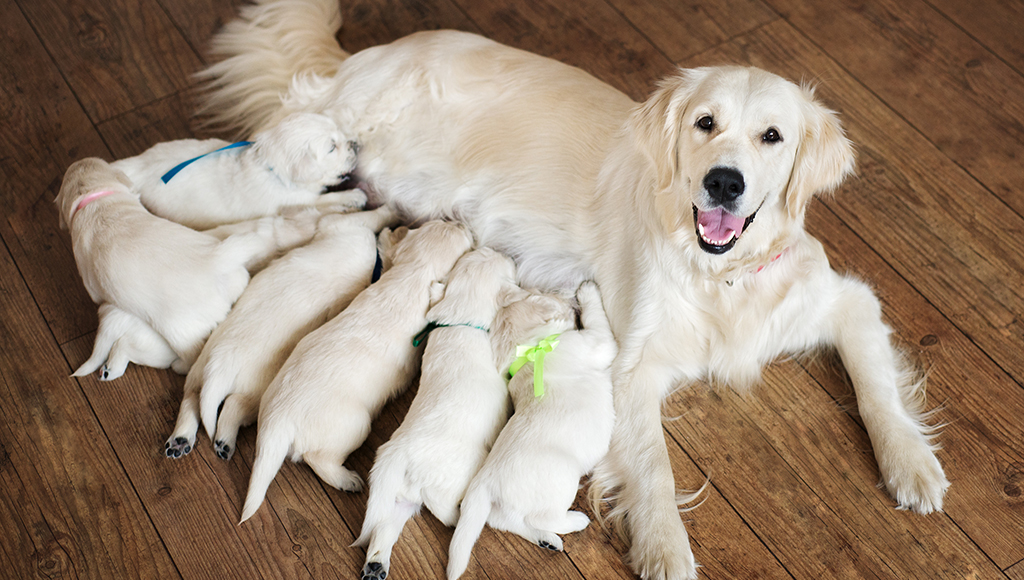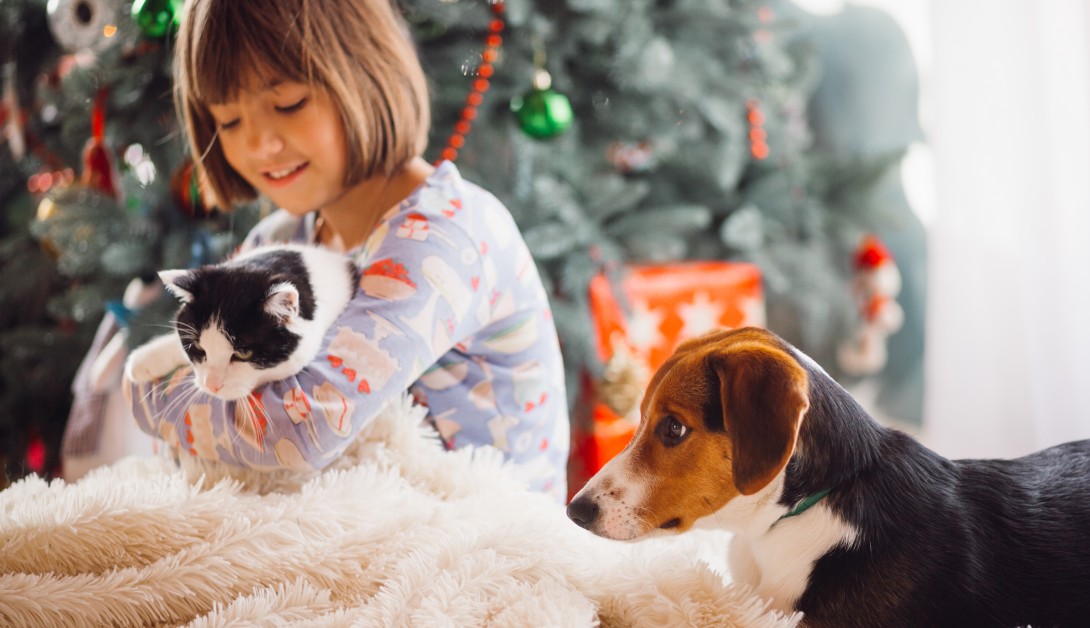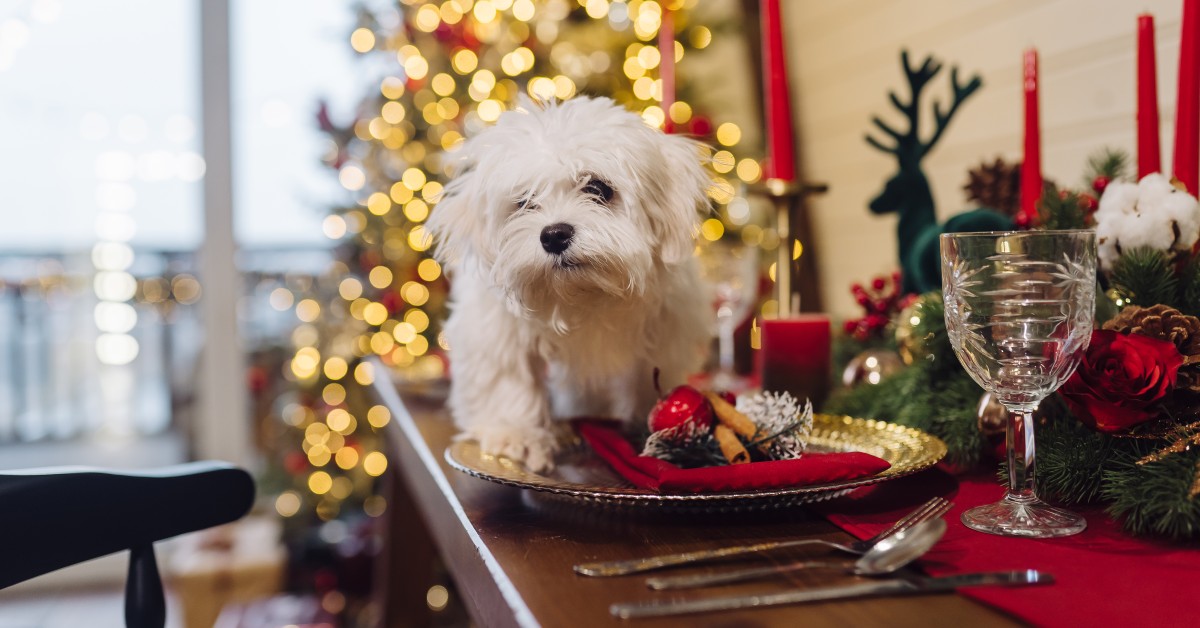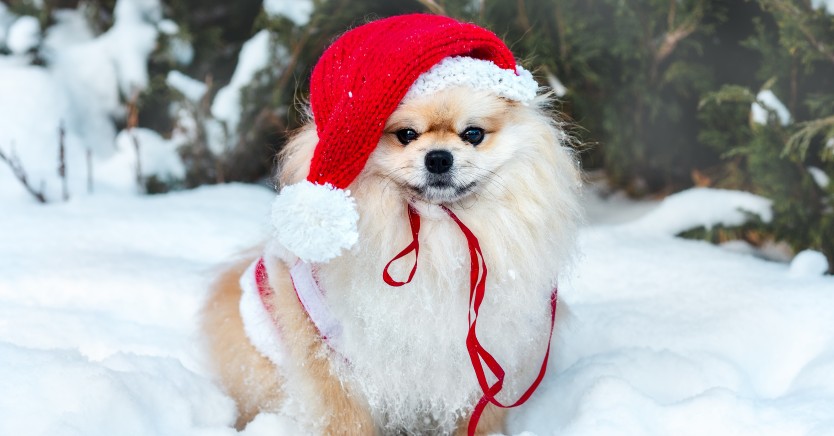Caring For Those New Puppies!
Helping the new mother care for and protect her new litter.

The puppies have arrived. They have been weighed and identified; they have nursed and are now sleeping quietly (except for the normal twitching). Now what? Your job is not over yet, in fact, it's really just beginning.
Nutrition and Feeding
The mother will be ready for some food and water. Bring the dishes to the whelping box, as she will not want to leave the newborn puppies. Do not leave the dishes on the floor in the whelping box, as the puppies could crawl into them. Hang the dishes from the side of the whelping box or offer her food and water at least every 2-3 hours to start. She should be taken outside on a frequent and regular basis to relieve herself.
Within 2-3 days, the mother's appetite will dramatically increase to 2-4 times her pre-pregnancy intake. She will need a near constant supply of a high quality puppy food (do NOT use large breed puppy formulas, which are generally lower in protein, fat, and minerals) and water to maintain her weight and health while feeding the puppies. She should still have her vitamin/mineral tablet. She should not look gaunt or thin if her weight is maintained. Ideally, she should weigh the same at the time of weaning, as she did when she was bred.
A healthy puppy is firm, plump, and vigorous. Puppies should nurse every 2 hours or so. If they nurse until their stomachs appear round and they sleep quietly, they are eating enough. If they are crying and moving a lot, they are not eating enough. They may be swallowing air, which makes the stomach appear larger. As they become weaker, they will lay still and not cry. A puppy may lose weight in the first 24 hours (less than 10% of birth weight), but after that, the weight should increase steadily. Their weight should double in the first 7-10 days. Before, during, and after nursing, the mother will lick the stomach and perineal area to stimulate urination and defecation. She will continue to do this for 2-3 weeks.
Puppies should gain 1-2 grams/day/pound of anticipated adult weight. Weigh the puppy daily for the first 2 weeks, then weigh at least weekly. A food scale typically works well for weighing the puppies. Failure to gain weight is often the first sign of illness in puppies.
At about 3 weeks of age, the puppies will begin to imitate the mother's eating and drinking. A secure shallow water dish should now be available at least part of the day. At 3½ weeks of age, the puppies can start receiving puppy mush.
Prepare the puppy mush by placing 2 cups of high quality dry puppy food in a blender with 12.5 oz liquid puppy milk replacer and fill the rest of the blender with hot water. This should be blended until the consistency of human infant cereal. (This feeds 6-8 puppies of a medium-sized breed.) The puppies should receive 3-4 meals a day of this to start. Once the puppies have checked it out, walked in it, and have eaten some, the mother can be allowed to finish it and clean the puppies off. Each week, increase the amount of food, decrease the amount of the milk replacer and water that is added and the time of blending, so by 7 weeks of age, the puppies are eating dry food. Once they are on dry food, it may be left in with the puppies (when the mother is out of the box) or the meal times can continue. As the puppies eat more solid food, the mother may be let away from the puppies for an ever longer period of time.
By the time the puppies are 6½-7 weeks of age, they should be fully weaned from the Mother's milk, eating dry food, and drinking water. If the weaning is not rushed, she will naturally start decreasing milk production, as the puppies increase their intake of solid food. As the puppies begin eating the puppy mush at 4 weeks of age, start changing the mother's diet back to adult food to also help her decrease milk production. Start by replacing 1/4 of her puppy food with adult food. Keep increasing the adult food and decreasing the puppy food until by the 7th week postpartum she is eating only adult food. During the last week of weaning, the mother's food consumption should be less than 50% above the maintenance levels and declining toward maintenance levels. Hopefully she has been fed well during pregnancy and lactation so she weighs the same at weaning as she did before pregnancy.
Sanitation and Housebreaking
During and after whelping, the mother should be allowed to go outside to urinate and defecate. Take her out on a leash (bring a flashlight if it is dark), and watch her closely, as she could have another puppy.
The whelping box needs to be changed at least once a day at this stage, and 2-3 times a day as the puppies begin eating solids and the mother is not cleaning up after them. A large heavy paper may be laid on the bottom, several layers of newspaper over that, and a tightly stretched blanket over the newspaper. The blanket should be large enough to fit under all 4 sides of the box. If the box was made so the sides set into the floor, the sides are picked up, the blanket stretched, and the sides set down to hold the blanket in place. Puppies can become lost under blankets or under wrinkles in blankets. When cleaning, check the consistency and color of the puppy stool. It should be brown and formed, but not overly firm. Any deviations and the veterinarian should be contacted.
To facilitate housebreaking, the puppies should be given definite feeding, playing, sleeping, and elimination areas. Once the puppies are mobile, they will use one area for elimination. To assist in housebreaking, a low board can be secured across the whelping box to divide the elimination area from the eating/sleeping area. Cover this area with a layer of newspapers with cedar or pine shavings on top. The new owners then place a small amount of cedar or pine shavings in the preferred location of their yard to aid in housebreaking. Keep the elimination area clean and dry.
Temperature
Newborn puppies are able to maintain a body temperature about 12°F warmer than the air temperature. The temperature under the heat lamp in the whelping box should be around 85°F for the first 2-3 days, and then can be dropped to 75-80°F depending on the surrounding temperature. A temperature of 70-75°F on the far side of the box is fine. Puppies head toward the heat source to nurse so do not have the heat source warmer than the mother. Hanging a household thermometer on the inside of the whelping box will help you know the temperature in the box. Puppies typically lay side by side or on top of each other to share warmth. If the puppies are scattered throughout the whelping box and away from the heat lamp, the temperature is too warm. If they are all piled on top of each other, it may be too cold. Puppies need the extra heat, as they are unable to regulate their body temperature until several weeks old. The rectal temperature of newborn puppies is about 97°F and rises each week until about 4 weeks of age when it is a normal adult temperature of 100.5-102.5°F.
Health of the Mother
Each mammary gland and nipple should be checked at least once a day for redness, hardness, discharge, or streaking color. If mastitis develops, the veterinarian should be notified immediately. If caught early, milking out the affected gland and applying hot compresses will help prevent a spread of the problem. Sometimes, antibiotics are necessary. If she gets multiple glands with mastitis, the puppies will need to be bottle fed. The puppies' nails should be trimmed weekly starting within days of birth. This will help prevent some of the scratches on the mother's mammary glands. The deciduous teeth start coming in around day 11. Check the mammary glands of the mother daily for bite marks.
The mother will have a bloody discharge from her vulva which may be quite heavy for several days. It should decrease in amount and become darker and be almost gone within 2-3 weeks.
The mother's hair may have become very thick and luxurious during the pregnancy. Around the time of weaning, the mother starts to shed. This extreme loss of hair coat is natural and it should be back to normal in about another 4-5 months. This shedding is more extreme than a normal shed cycle and some mothers become quite bald. This is often called 'blowing a coat.'
Puppy Healthcare
Puppies who are not thriving should be examined as soon as possible by a veterinarian to check for birth defects. Some defects, such as a cleft palate are not compatible with life. These puppies should be humanely euthanized.
Dewclaws are removed and tails docked at 2-4 days of age. Make an appointment with your veterinarian for these procedures to be done. Check your breed's standard, as some breeds need to have dewclaws left intact in order to show. Tail length changes, so again, the current breed standard should be consulted. When the puppies are at the clinic and having these procedures done, the mother should be taken for a walk around the block until the puppies are done. She should not be close enough to the clinic to hear the puppies crying. Once they are put back with the mother, the puppies normally nurse and then sleep.
Vaccinations are started at 6-7 weeks of age. Some breeders give a parvo virus vaccine at 5 weeks of age, if the puppies are at a high-risk. Ask your veterinarian if your puppies should be vaccinated early for parvo virus.
Strategic deworming is a practice recommended by the American Association of Veterinary Parasitologists (AAVP) and the Centers for Disease Control and Prevention (CDC). They recommend puppy deworming for roundworms and hookworms start at 2 weeks of age and be repeated at 4, 6, and 8 weeks of age. Thereafter, use a heart worm preventive medication that is also effective against hookworms and roundworms. Drs. Foster and Smith suggest that owners of newly acquired puppies obtain the deworming history of their new pup and contact their veterinarian to determine if additional deworming is needed. The mother should be dewormed at the same time as the puppies.
A health check done by a veterinarian at 6-7 weeks of age before the puppies head for new homes should include checks for heart murmurs, hernias, cryptorchidism, demodectic mange, other parasites, eye disorders, etc.
Normal puppy development
The umbilical cord normally falls off within 2-3 days of birth. Infections of the umbilicus are rare in clean, well-managed kennels.
Puppies normally twitch and jerk while sleeping. This helps with the development of their nerves and muscles.
The puppies crawl well by 7-14 days, walk at 16 days, and have a normal gait at 21 days. They need to be on footing that offers traction. By 4 weeks of age, the puppies follow each other and carry toys in their mouths. They will play-fight with each other and learn how to inhibit their bites. If a puppy bites a littermate too hard, the littermate will yelp and stop playing with him. If the puppy is allowed to bite humans, he will not learn to inhibit his bite. It may be cute as a 7-week old, but it will not be as a 7-year old.
Puppies are born without teeth. The deciduous (baby) teeth start to erupt at 2-4 weeks of age. All of the deciduous teeth are usually present by 8 weeks of age.
The puppies' eyes will open around 12-15 days of age. The retina matures around 21 days of age. Puppies should see clearly by 4 weeks of age. Do not pry open the lids for any reason, as the immature eye is not yet ready to handle light. If the eyes appear swollen before they open, take the puppy to a veterinarian immediately as an eye infection may be present that needs to be treated to prevent loss of vision. Some puppies will take a day to open the eyes while others will take 3-4 days. The eyes will have a bluish color to them at first and then change to their adult color over time. If the eyes appear white or solid blue, take the puppy to the veterinarian right away.
The ears open at 14-17 days of age. They should hear clearly by 4 weeks of age. Deafness may not be noticeable while the puppies are together and first noticed when the puppy is in her new home.
Interactions Between the Mother and Puppies
By the time the puppies are 2-3 weeks old, the mother should have an area near the whelping box, but separate from the puppies to allow her time to rest. At about this time, the puppies will start trying to leave the box to explore. They should be well supervised and have safe toys available. The box at this point should be big enough to be divided between eating, sleeping, playing, and eliminating rooms. At this stage, a crate with the door removed and lined with sheepskin or a dog bed can be given to the puppies for sleeping quarters and to familiarize them with crates.
Puppy Socialization
Early socialization of the puppies will help them become confident and develop fewer behavior problems. The puppies should be exposed to everything possible from metal food dishes dropping, to vacuums, garage doors opening and closing, thunderstorms, sirens, garbage trucks going past, cats, and other pets, etc. Do not try to keep the area quiet during the day. The puppies need to get used to normal household noises. Children should be allowed to play outside the whelping box (supervised so they do not enter the box or drop toys in), as children behave differently than adults. Everything the puppy is exposed to now, will help her become a well-socialized, unafraid adult. The puppies should be handled several times a day. They can be picked up, their teeth looked at, ears checked, toes played with (nails will need a weekly trimming), and have anything that may be done as an adult started slowly now. Play helps to develop the puppy's mind, as he needs to find solutions to problems he encounters. If the puppies are not in new homes by 10 weeks of age, they should be separated from each other for a large part of the day and given one-on-one time with humans. They can have play times during the day, but they should eat, sleep, and be handled separately. Being in a kennel (group) situation beyond 10-12 weeks of age decreases trainability.
Ready to start saving money on pet wellness care?
Then take a look at Mint Wellness, the pet wellness plan that provides fast reimbursement on routine pet care. Save on vaccinations, wellness exams, preventatives, dental, and more!
Learn More


